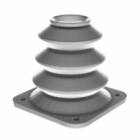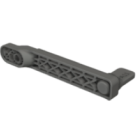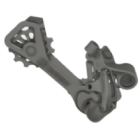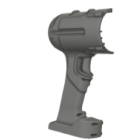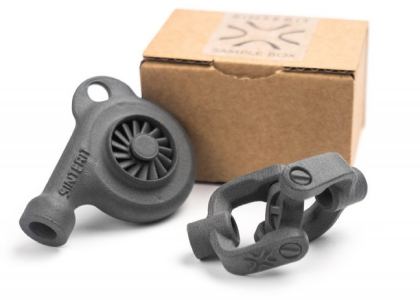Automation 3D printing
Automation in 3D printing has moved well beyond the realm of futuristic speculation — it’s now a crucial driver of scalable, consistent, and cost-effective additive manufacturing. As the technology continues to mature and gain traction across industrial environments, manufacturers are increasingly seeking ways to minimize manual labor, streamline workflows, and enable continuous, around-the-clock production.
But automation is more than just a tool for convenience — it’s the foundation for making large-scale 3D printing truly practical. Within industrial additive manufacturing, automation plays a vital role in ensuring process repeatability, supporting certification compliance, and lowering the cost per part — the three core elements needed to take AM from prototyping to full-scale production.
Where automation begins: beyond the printer
The automation of 3D printing doesn’t stop at pressing “Start” on a machine. In fact, it begins well before the first layer is deposited. Automated part preparation — including AI-based orientation, nesting, and slicing — is now being integrated into modern software platforms. These systems evaluate not only printability but also thermal behavior, build efficiency, and downstream post-processing needs. Advanced algorithms can even predict heat accumulation and recoater interactions in powder-based systems, preventing print failures before they occur. A fully automated pipeline starts with data, not hardware.
Automation also extends to file handling and queue management. In multi-printer environments, especially in print farms, automation tools dynamically assign jobs based on material availability, machine readiness, and estimated completion time. This significantly reduces downtime and improves fleet utilization without human oversight.
Robotics and handling systems
Physical automation has advanced significantly, particularly in powder-based and resin-based technologies. Robotic arms are now used to remove prints from build platforms, transport them to cleaning stations, and even begin post-processing steps. In metal additive systems, robotic manipulators also handle heavy build plates, minimizing operator exposure to heat and powder contamination. In powder bed fusion (PBF) systems, automated depowdering and material refresh cycles are being deployed to eliminate one of the most labor-intensive steps in the workflow.
Integrated solutions also exist where conveyors and robotic carts move build chambers between stations — from sintering to cooling, to unpacking, to finishing — enabling a lights-out manufacturing environment. This type of setup, while still relatively rare, is gaining traction in industries like aerospace, where build cycles are long and production standards are extremely high.
Smart monitoring and self-correction
Advanced automation is deeply tied to sensor data and machine learning. Modern 3D printers are equipped with cameras, thermocouples, and vibration sensors that feed real-time data into intelligent control systems. These systems can detect a failed first layer, inconsistent extrusion, or heat anomalies — and either pause the job or adjust parameters on the fly.
This shift from reactive to proactive correction is key to enabling automation. No human operator is fast enough to spot a microscopic deviation on layer 372 — but an algorithm is. Self-monitoring ensures that longer print jobs, especially those spanning dozens of hours, can be completed without constant supervision. The most advanced setups implement closed-loop feedback, where sensor data directly modifies process parameters — enabling real-time stabilization of melt pools, laser power, and chamber conditions.
Post-processing and workflow integration
Automated post-processing is becoming more sophisticated, particularly for SLS and resin-based technologies. Depowdering units, washing and curing stations, and surface finishing machines are now fully programmable. With the right setup, a part can move from build to finish without a single human touchpoint.
The bigger picture lies in workflow integration. When printing, post-processing, and inspection are all linked via a shared automation platform, traceability and repeatability improve significantly. This is especially valuable for regulated industries, where documentation and validation are non-negotiable. Integration with MES and QMS systems allows automated generation of build reports, material trace logs, and process certificates directly linked to each part ID.
The benefits and trade-offs
Fully automated 3D printing setups offer numerous benefits — reduced labor cost, consistent part quality, and increased throughput. However, automation also introduces complexity, requires upfront investment, and needs a different kind of operational expertise. It’s not always the right choice for prototyping labs or job shops handling one-off parts, but it becomes indispensable in serialized production environments. In essence, automation transitions additive manufacturing from a manual craft to an industrial process — one defined by consistency, not creativity.
Future outlook
As materials become more predictable and software grows smarter, automation will become the default rather than the exception. Expect to see more self-driving print farms, automated material hoppers, real-time defect detection, and full MES (Manufacturing Execution System) integration tailored to additive manufacturing. Collaborative robotics (cobots) and AI-driven scheduling will further merge physical and digital automation, creating adaptive production lines that self-optimize across multiple printers and materials.
In the long term, automation is what will enable 3D printing to compete with — and in some cases replace — traditional manufacturing at scale. The manual era of 3D printing is ending. What comes next is intelligent, connected, and largely autonomous.
Explore also
- Is 3D printing the future?
- What is the future of 3D printing?
- Future uses of 3D printing
- 3D printing vs traditional manufacturing
- What will 3D printers be used for in the future
- Trends in additive manufacturing
- AI in 3D printing
Related categories




